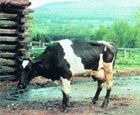USDA ruling may call DVMs to action in BSE surveillance
Washington-In the wake of the country's first case of mad cow disease, the United States Department of Agriculture's (USDA) ruling to ban all non-ambulatory, disabled livestock from being slaughtered may mean that the government will rely on veterinarians and producers to get access to test animals at highest risk for mad cow disease.
Washington-In the wake of the country's first case of mad cow disease, the United States Department of Agriculture's (USDA) ruling to ban all non-ambulatory, disabled livestock from being slaughtered may mean that the government will rely on veterinarians and producers to get access to test animals at highest risk for mad cow disease.
The first U.S. case was detected in December.
Dr. Ron DeHaven, chief veterinary officer for USDA, says the Secretary of Agriculture's decision to ban nonambulatory disabled cattle from entering slaughter plants also means that the government has to revise its surveillance programs.

Government officials field questions regarding the investigation into the first known mad cow disease case. At center stage, Dr. Ron DeHaven, chief veterinarian, USDA; Dr. Stephen Sundlof (left), Food and Drug Administration; Daniel Engeljohn, director of Policy Analysis, USDA Food Safety and Inspection Service.
At presstime, USDA was in the process of doing just that.
DeHaven explains, "Now that those animals, or the preponderance of nonambulatory animals-will not be going to slaughter, our efforts right now are focused on modifying our surveillance systems so that we still have access to that population of animals."
DeHaven adds, "Clearly we think that nonambulatory animals, particularly the older nonambulatory animals, are the population at highest risk and therefore the group that we want to continue to focus our surveillance on.
The message is, USDA does not want to curtail testing, so they will need access to this group of animals deemed of highest risk for having BSE through rendering plants or those animals on the farm.
DeHaven explains, "We think the most likely route there is is working through the American Veterinary Medical Association and the local practitioner who has established that relationship with the dairy farmer. So, we will be refocusing our effort to have access to those same animals, but before they would be going to slaughter. "
Secretary of Agriculture Ann M. Veneman made the decision in late December after the National Veterinary Diagnostic Laboratory confirmed the positive BSE case, which originated in Canada.
In early January, the Harvard Center for Risk Analysis (HCRA) released a second assessment of an initial 2001 study gauging actual risk of BSE spreading extensively in the United States was low because of the safeguards already in place.

Bovine spongiform encephalopathy under the microscope. Following the onset of clinical signs, the animal's condition deteriorates until it either dies or is destroyed. This process usually takes from two weeks to six months.
Surveillance efforts
Dr. Lisa Ferguson, senior staff veterinarian with the Animal and Plant Health Inspection Service (APHIS), adds that both producers and private practitioners have always been a part of USDA's surveillance, just by reporting odd clinical signs.
"If an animal was acting weird, we would do a foreign animal disease investigation. That has always been part of our surveillance," Ferguson adds.
"A significant portion of our surveillance has been obtained from non-ambulatory animals. Not only is that a high-risk population, to a certain extent, it was easy and efficient (to gather samples)."
While Ferguson did not have the exact breakdown in numbers of non-ambulatory samples collected, she adds, "Our assumption is that a large portion of them are in the slaughter for human consumption chain."
With USDA's policy change prohibiting downers from entering the human food chain, she adds that officials are working with industries and various groups to try to ensure access to those animals at highest risk.
"We are also working with producer and practitioner groups to build on what we have done in the past and continue those efforts," she explains. "We are kicking around lots of different options and looking at different things we can do. We have not finalized any plans just yet, but that will be coming up in the near future."
Ferguson says that communication will not include regulatory changes and will be communicated through practitioner/industry groups.
She adds that if veterinarians have questions, they should contact their APHIS area veterinarian in their state.
Price tag
While veterinarians say they understand USDA's decision to ban all nonambulatory disabled cattle from the human food chain as a conservative approach to managing this BSE case. The decision comes with an economic price tag for producers and restricts safe meat from entering the food supply.

This English cow was diagnosed as having mad cow disease, which is a slowly progressive degenerative disease that affects the central nervous system of adult cattle. The typical incubation period for BSE is from two to eight years.
However, veterinarians report the consumer confidence in the safety of the nation's food supply is of utmost importance. In other words, it's the cost of doing business.
Dr. Bob Smith, a feedlot consultant and chair of the National Cattlemen's Beef Association's (NCBA) Animal Health and Well-being Committee, says that there needs to be a clear distinction between sick and injured animals entering the food chain. "Sometimes that distinction gets blurred with the media."
Smith explains that sick animals should never be allowed in the food chain, but injured animals following an antemortem and postmortem inspection pose little risk to consumers.
"If an animal had a fracture or some other acute injury, and they were bright and alert and passed both the antemortem and postmortem inspection they allowed that. There is very little risk to the food supply from animals harvested under those conditions."
But there is always the public perception. "Out of an abundance of caution, they (USDA) decided not to allow those animals from entering the packing plants any more. I think we have to go ahead and support that just to minimize the possibility of error and to maintain consumer confidence in the product."
Dr. Andy Johnson, a dairy practitioner with Total Herd Management Services, of Clintonville, Wis., concurs there is an economic pinch for dairy practitioners simply because dairy cows that head off to slaughter are typically older animals and more likely to sustain injury. Nerve paralysis while birthing is also a pretty common reason for culling an animal from the dairy herd, and he adds, that animal poses little risk to the food supply.
He says of USDA's decision, "I think they are taking a very proactive stance right away. Once they have a chance to take a deep breath, they will probably fine tune some of these things a little bit."
Smith concurs.
For feedlots "there are some economics tied to it. If you have a 1,200-pound animal ready for market, we have a lot of money invested in it. If they have an acute fracture, there is a lot of salvage money for those animals and that meat is safe to enter the food supply," Smith explains. "On the other hand, when you look at the proportion of animals that have been marketed that have been non-ambulatory because of injury. In the larger scheme of things, it represents a very small percentage of the cattle entering the food supply."
Johnson says he hasn't fielded that many questions about BSE from his clients. He believes that because the one case is so isolated, producers are confident the disease will not make inroads in this country.
"The risk to our meat supply is so miniscule that I really don't think it is a huge issue. With that said, it should give people confidence that we have enough safeguards in place that we can stay ahead of this rather than let it get out of hand."
On the other hand, being active with NCBA, Smith has fielded many media questions about BSE.
"Our producers are very concerned about this case, not only because there is an economic issue, but like everyone else they are very concerned about the safety of the food supply. I think, thus far, based on the investigation by our government officials, I think we have determined that there is essentially no compromise in the safety of the beef supply because of this one cow."